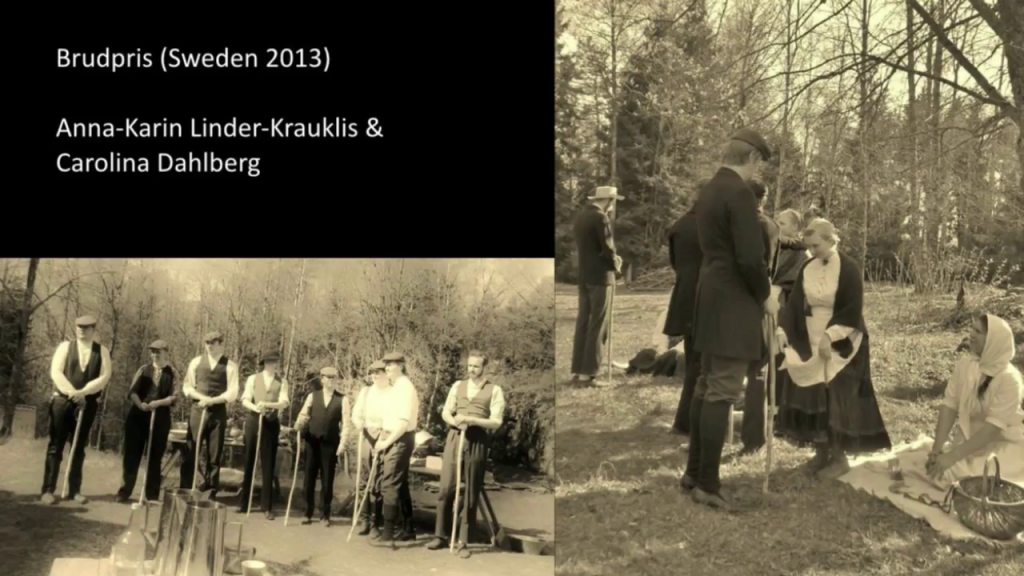
This is Kon-Tiki, a raft on which Thor Heyerdahl sailed from Peru to Polynesia in 1947. He did it to show that South Americans could have settled Polynesia. This is maybe the most famous example of experimental archaeology, a field which attempts to test archaeological hypotheses, often trying to replicate ancient techniques. In experimental archaeology, we could for instance try to make the kind of shoes that our hunter-gatherer ancestors might have had, and test how long they last in use.
But what if we are interested in completely different kinds of questions? Like, did they have rules for whom you’re allowed to have sex with? How did they raise their kids? We could always look at existing hunter-gatherer cultures and guess that the culture might have been similar. But could we attempt to test our hypotheses, someway?

Photo: Xin Li
This is KoiKoi, a larp about a hunter-gatherer people called be Ankoi. Their culture contained various costumes adapted from real-world hunter-gatherer tribes. For instance, they had three genders, and a woman’s brother was seen as the father of her children.
The game was not set in a definite historical time or place. However, it was not fantasy. There were no elements that would have been impossible in the real world. The focus was on the culture. In KoiKoi, you could try for yourself how it is to live without laws, institutions, or formal hierarchies. Or without reading or writing. It felt like a playful analogue of experimental archaeology, so I baptized the genre “experimental anthropology.”
The game materials, an audio book and its transcript were in the form of a first-person story where an Ankoi explains the customs and beliefs. I interpreted them as recordings and field notes made by an anthropologist studying the Ankoi.

Another example is Brudpris, a game about patriarchal honor culture. It was about a Nordic people called Mofolket. They believed that there is a dangerous life force in women. To control it, men had to control every aspect of a woman’s life. If she would show signs of being out of control, they would punish her. If the man didn’t succeed in doing this, he would lose honor.
The game material contained extracts from a fictitious anthropological study, and some of the characters actually were anthropologists who were doing research on Mofolket. And in fact, in both KoiKoi and Brudpris, some of the organizers had anthropological education.

But can we really learn about other cultures through larp? Making a pair of shoes can tell us about ancient techniques. However, trying a social custom for a couple of days is completely different from being socialized to it from your childhood. When we play a different culture, we build its image based on our own cultural preconceptions. In the end, it mainly teaches us how we see an other culture, not how it is to actually live inside that culture.
And actually, even very simple things such as physical comfort can depend on culture. When I was living in Japan, I once went to a store to look for a soft pillow. And I asked the storekeeper, an old lady, about it. It was a very traditional kind of store. And she actually thought I was using the wrong Japanese word, that I was meaning actually something else than soft. Because who would like to have a soft pillow, anyway?
So, playing in a game like KoiKoi doesn’t really give us much real insight into the cultures of the real-world hunter-gatherers, especially not those that lived thousands of years ago. And Brudpris does not help us understand real-world honor societies. There is only one way to really understand different cultures. You go there, and you live with the people, and as the late anthropologist Clifford Geertz quoted, “You try to find your feet.”

Photo: Xin Li
So, is it meaningful after all to talk about experimental anthropology? Can larp teach us about culture? I’d say yes. Because anthropology is much more than learning about other cultures. It gives us something that is perhaps even more valuable, reflection on our own culture. It makes us see our own norms and cultural assumptions in a new light. And this I believe can be achieved in larp. After KoiKoi, it’s quite clear to me that there’s little difference between the contemporary custom of applying lipstick and that of Ankoi body painting. Thank you.
Further Reference
Overview blog post for the 2015 Nordic Larp Talks, and for this presentation
The original event listings for KoiKoi and Brudpris.
Brudpris page at the Nordic larp wiki.
“Experimental anthropology at KoiKoi”, by Kaisa Kangas.
